In a perfect world, we would be“one-size-fits-all” human machines. Happy and energized, we would move through work, leisure, exercise, and everyday life situations in perfect stride. Our“engines” would burn exactly what we consume each day, and we would have the same results from any diet and exercise plan we tried. Now, let’s get back to the real world, the one in which we all struggle to just maintain our individual machines. Stop and think about it; you are a unique individual. And because of that, not all pre-packaged diets and fitness plans can possibly work for you.
While we all share a common goal of optimal health and fitness.
In America, one out of every two people is on some kind of diet. Because we are truly unique in our thinking, physical make-up and fitness goals, we must follow different paths on our journeys. What works for you may not work for me and that’s precisely what is wrong with cookie cutter diets so pervasive in today’s culture.On any given day inAmerica, one out of every two people is on some kind of diet. We gain and lose, only to regain again and move on to the next diet craze. Diets don’t work because they force us to bend our lifestyles in an unknown and possibly unwanted, direction Without a detailed map to familiarize us with this new direction, our journey usually ends up back where we started—the only place that remains familiar after trying to live someone else’s life. This is why the Body of Knowledge System works.
It offers a way of eating that is in harmony with the way the human body is designed and operates, but that also allows for our individual differences. We are all based on the same structure but possess individual systems of operation tuned to the way we live our lives.I don’t want to change you; I want to help you find harmony in your lifestyle so that you can go back to the healthy, vibrant person that you were meant to be. Our lifestyles get twisted from all the different messages we are sent about what looks good, tastes good and how we should feel. Use this book to unravel all the bad messages and find the lifestyle that meets your specific needs. Then you’ll have your best chance ever at managing your ideal weight and fitness permanently.
Two Ways to Find Your DietI’ve never liked the word diet because it conjures up images of deprivation; a short-term unnatural state of existence. But the dictionary definition of diet is: the usual food and drink of a person or animal. That’s how I would like you to think of the word diet from now on. Your Body of Knowledge program will include your own personalized eating plan that will become second nature to you. As with anything you have to learn, like speaking a foreign language or a particular skill, you have to think about it at first, try it out, and then it becomes a part of you, like riding a bicycle. You will naturally adhere to a way of eating and exercising because you will feel better and look better. I am really just encouraging you to make smart choices. You should want to choose the orange over the Oreo – because it makes you feel good.
Quite possibly for the first time in your life, you will be eating in a way that is natural to your daily routine, from the time you wake up until the time you go to bed. For example, are you starving as soon as you wake up in the morning? Then, that is when you’ll have your first meal. Can’t stand the thought of food first thing in the morning? Then you’ll wait an hour or two before you eat. Is lunch your favorite meal of the day, or is it dinner? Whichever, you will eat your “big meal” according to your preference.
There are only three suggestions I have if you truly want to manage your weight and attain optimal health:
1. Stay close to your daily target calories and optimal fuel proportions.
2. Eat 5-to-7 times a day—that is, less food more often.
3. Eat more unprocessed foods and minimize the processed items, including food additives (such as salt).
Developed my two primary BOK meal plans, for Fat Loss/Weight Maintenance and AcceleratedFat Loss to help you achieve your ideal weight, peak energy level and optimum health. If you are at your ideal weight now, the BOK Fat Loss/Weight Management MealPlan will allow you to stay there forever. If you are overweight now, this plan will help you lose fat and weight, gradually and healthily until you reach your goals. Then without changing a thing, you will be able to manage your weight and fitness easily. Fat loss may come slowly at first, but it will come without starvation or ridiculous restrictions. You will naturally eat your way to your new healthy weight. If you want to lose fat at a faster, but still safe pace, you can follow the BOK Accelerated Fat Loss Meal Plan.
Depending on your current weight, you could lose pounds and fat faster in the first month and continue to lose each month until you hit your healthy target weight. At that point you can switch to the BOK FatLoss/Weight Maintenance Meal Plan, which will enable you to remain at your healthy weight. Both plans will teach you to properly balance your carbohydrate and protein intake, make healthier food choices and choose better serving sizes. The food item or meal percentages are generally expressed in terms of calories by government recommendations and scientific studies, but you will be making most of your decisions based upon grams. The following section explains how easy it is to calculate our meal percentages and serving sizes using each method.Calories vs. GramsDepending on whether you are counting grams (amount of food) or calories (for your energy intake), there is some variation in the protein to carbohydrate ratios I propose in my dietary plans. Evaluating gram percentages is the easiest way to track your fuel in take and is the reason the BOK Six Fuel Groups food classification system works so well to help you make food choices. Percentages based upon gram values are better suited for your daily encounters with food la- bels, restaurant menus or prepared meals for nourishment.
Percentages based on calorie values give a better big picture when evaluating your daily or weekly calorie totals. Here are two general rules to follow:
1. Use gram/weight fuel percentages in restaurants, when reading labels, when you are on the go and food size is your only cue.
2. Use calorie/energy fuel percentages when calculating your daily or weekly calorie intake and when comparing government and industry standards.
Use the gram percentages when weighing food and adding up grams on food labels, but use the ratios when ordering meals or any place where they are prepared according to other standards. Whether it is a frozen dinner, a bowl of cereal or a pita pocket filled with tuna salad from a restaurant, weight and ratios directly correspond to the size of the portion, not the number of calories contained in the food. For example, don’t think that eating within the BOK Fat Loss/WeightMaintenance percentages means that 25 percent of the food on your plate can be fat. That 25 percent refers to calories which cannot be visualized, but both plans use 10 percent fat for the size (gram) ratios. This simply shows that the butter, oils, or other fat products in your meal should visually be about one-tenth of the food on your plate, not a quarter.Your carbs and protein consumption are even easier.
For example, if you follow the BOKAccelerated Fat Loss Meal Plan (1:1 carb to protein ratio), make sure that the amount of chicken breast (protein) you are eating is about the same amount as your portion of brown rice and broccoli (carbs). Similarly, if you are following the BOK Fat Loss/Weight Maintenance Meal Plan (2:1 carb to protein ratio), make sure that your meatballs (protein) are at least half the amount of the spaghetti (carbs) on the plate.If this is enough math for you and you feel good about making these deci- sions on your own, then I have done my job. But if you are a science geek like me and want to know the details, the website offers a full explanation in “Grams andCalorie Conversions”.
BOK Meal Plan
Fat Loss/Weight Maintenance
Principle 1: How Much to Eat
If you haven’t done so already, goto the website and calculate your daily calories. Be honest about your activity level. An office worker is probably not as active as a sales clerk in a busy department store or a construction worker. You will have a better understanding and make better choices with the BOK Activity and ExercisePlanner on the website after reading Parts 3 and 4. Your calorie energy ratios and food weight ratios, as explained in Principle No. 1, are as follows:
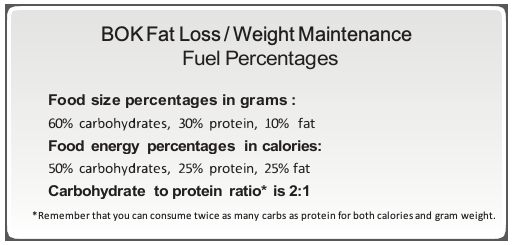
Principle 2: How often to Eat
There are two possible approaches to determining how many calories you should consume each time you eat. With the agreement that you should be eating a minimum of five times a day, logically you would divide your calories equally among your meals.
For example; 2000calories divided by five meals is 400 calories per meal. Eating the same number of calories every two and a half to three hours is the ideal way to keep your insulin levels steady.
Most people, however, prefer to have a “bigger meal” or two during the day. Not only does this follow old traditions, but these meals may also be necessary to fuel your body at certain times of the day when you are burning more energy. Depending upon your workload or exercise schedule; lunch, dinner or your late snack can be larger than your breakfast and early snack, or vice versa. The rule of thumb is that the caloric value of your largest meal should not be more than twice the value of your calories of any other meal if they are split evenly.
For example, an even distribution of a 2,000calorie-a-day plan is 400 calories per meal. Therefore, the largest meal of the day should be no bigger than 800 calories.
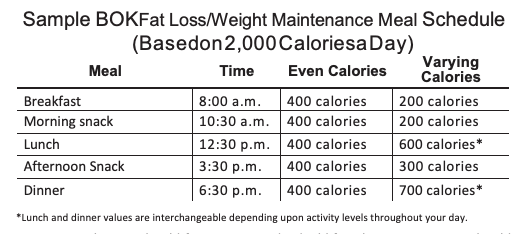
Principle 3: What to Eat
All six food classification groups are allowed, but you should primarily be eating from Groups 1, 2, and 3. Eat fromGroups 4 and 5 occasionally for better overall health, but sticking to the first two principles will usually limit these groups automatically. See Food Groups
Your best choices are lean proteins, complex and unprocessed carbohydrates, and either polyunsaturated or monounsaturated fats. Group 6 falls into the “occasional” and “limited” category. Sometimes you just crave something from this group and nothing can stop you.
When this happens, if your overall day still complies with Principles 1 and 2, then there really is no serious damage done. If your daily diet has been compromised by too many bad choices then resume your good habits at your next meal, scale back a bit on your total daily calories the following day or not chit up a bit at your next exercise session. After all, we are all human. But remember, if you are craving something from Group 6, practice good label scrutiny with processed foods to help keep you on the straight and narrow.
The basic guidelines for the BOK Fat Loss/Weight Maintenance Meal Plan as applied to the BOK Six Fuel Groups are shown in the table on the next page. Also shown is a sample daily menu for someone in the 2,000 calorie-a-day range who likes to eat smaller meals in the morning and a large dinner. Any combination of calories will work but consuming more than 50 percent of your total daily calories in your breakfast, morning snack, and lunch is a better scenario (for lower insulin levels at night when you are less active).
For example; 2000calories divided by five meals is 400 calories per meal. Eating the same number of calories every two and a half to three hours is the ideal way to keep your insulin levels steady.
Most people, however, prefer to have a “bigger meal” or two during the day. Not only does this follow old traditions, but these meals may also be necessary to fuel your body at certain times of the day when you are burning more energy.
Depending upon your workload or exercise schedule; lunch, dinner or your late snack can be larger than your breakfast and early snack, or vice versa. The rule of thumb is that the caloric value of your largest meal should not be more than twice the value of your calories of any other meal if they are split evenly. For example, an even distribution of a 2,000calorie-a-day plan is 400 calories per meal. Therefore, the largest meal of the day should be no bigger than 800 calories.
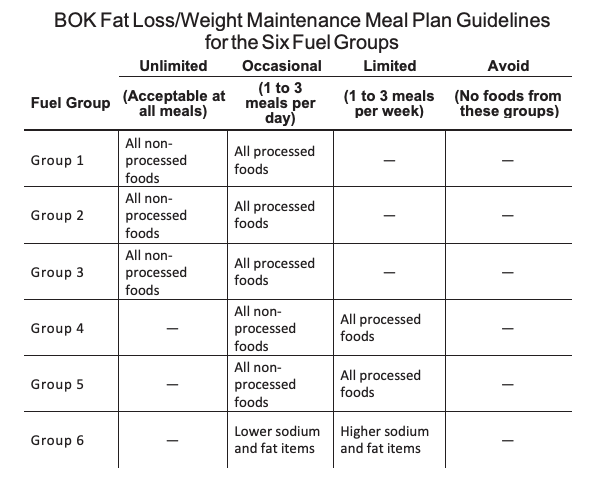
Your meal times should fit into your individual lifestyle. However, you should wait a minimum of one-and-a half hours before your next meal, and do not go longer than three hours between meals.
See Food Groups
Sample BOK Fat Loss/Weight Maintenance Daily Menu
(Based on 2,000 Calories a Day)

BOK Meal Plan
Accelerated Weight Loss Plan
Principle 1: How Much to Eat
The first step to accelerated weight loss is eating fewer calories per day. Your daily calories calculated on for the BOK Accelerated FatLoss Meal Plan will be 20% less than the maintenance meal plan. For example, if you need 2,000 calories to maintain your goal weight, you would subtract 400calories (2000 calories X 0.2) to get to your Accelerated Fat Loss daily target: 1,600 calories. Note that this is not a starvation diet. And you will still feel satisfied because you will eat six times a day. Your daily caloric ratio and food weight ratios are as follows:
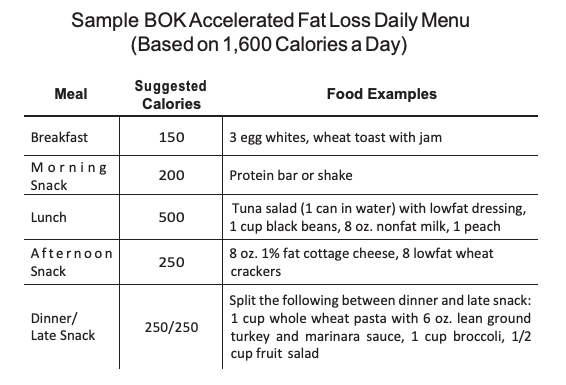
Principle 2: How often to Eat
As explained above, you will get the best results by dividing your calories equally throughout the day, but only a small minority of people can do this and still remain satisfied. Most people need to vary their calories, though the distribution for this plan differs slightly from the BOK Weight Maintenance/Fat Loss Meal Plan.
Instead of five meals a day, there are six, with the addition of a late snack (or part of your dinner saved for this later snack).Lunch should have a caloric value close to dinner and the late snack combined. The late snack should be eaten at least two hours before bedtime.Also, the calories of the largest meal should be no more than three times the amount of the smallest meal.
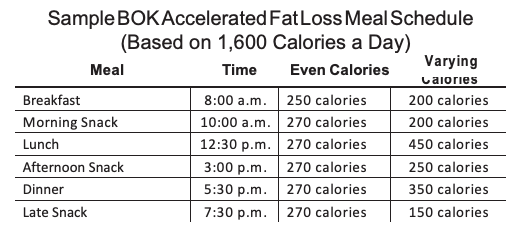
Principle 3: What to Eat
The rule of thumb for this plan is to stay within Groups 1, 2, and 3 (unprocessed items only). The closer you stick to this, the more progress you will make. Complete abstinence of Groups4, 5, and 6 may not be realistic for you, but do your best. Incidental fat will be introduced into your diet from natural foods. If you have to pick a fat fromGroup 5, make sure it is monounsaturated or poly un- saturated. I recommend avoiding Group 6 completely which will help you steer clear of the FatCocktails. See Food Groups

Your meal times should fit into your individual lifestyle. However, you should wait a minimum of one-and-a half hours before your next meal, and do not go longer than three hours between meals.
Also, try to stay away from foods in Group 3 that are simple sugars and select more unprocessed items that offer complex and fiber rich carbs. Packaged foods will present the biggest challenge so carefully read ingredient lists on labels for hidden sugars and high glycemic carbs. A food may be low in fat but the amount of simple carbohydrates it contains could be very high which can invite that insulin rush you want to avoid.
See Food Groups
Sample BOK Fat Loss/Weight Maintenance Daily Menu
(Based on 2,000 Calories a Day)

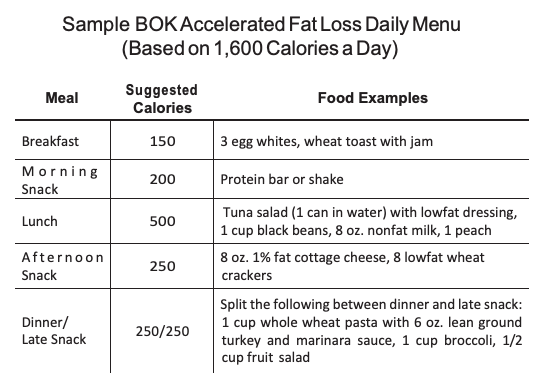
MEAL PLANNING
Breakfast
If you insist on eating simple carbs, this is one of the meals in which to enjoy them! Your blood sugar is low when you wake up. But make sure you keep insulin from climbing too high by limiting their amount and combining your simple carbs with protein, complex carbs or a little fat.
For example, if your simple carb is some jam, put it on a piece of whole-wheat toast with adab of butter. Oat- meal is also a great morning carb. It is complex, and you can add a little sugar (or fruit is a better choice) and some low fat milk which will give you some protein and fat to help keep your blood sugar in line.Protein is tough to incorporate in the morning meal because quality sources are difficult to come by, especially if you are in a hurry and don’t have time to prepare a cooked meal.
Sometimes I have some leftover meat from dinner that I eat with some fruit, but the traditional egg is still one of my favorites. And if you are on the accelerated plan, it couldn’t get any easier with egg whites now pre-packaged in cartons ready to just pour into the frying pan or cook in the microwave. If you like the yolks, they carry only 5 more grams of fat, so leaving one or two in the bowl is fine if you are separating the whites from whole eggs. Even if you only spread a little cream cheese on toast or have a bite of sausage, make sure you get some protein in the morning.It isn’t necessary to eat the moment you jump out of bed. Stick to the adage “eat only when you are hungry.” But when you do feel that first hunger pang, have something to eat. Don’t let a busy schedule keep you from eating, and make sure you have your first meal within two to three hours of waking.
Most importantly, forget the old wives’ tale about eating a breakfast “fit for a king.” Breakfast should be one of your smallest meals for two reasons. Your stomach is at its smallest when you wakeup because of the overnight fast and you don’t want to arouse your blood sugar and insulin levels too quickly. If you start an insulin and blood sugar rollercoaster ride in the morning, it can rage out of control all day.
MEAL PLANNING
Morning Snack
Your morning snack fuel ratios should be similar to what you had for break- fast. It should contain the same amount of calories, more if your lunch portions are conservative and you are exercising at lunch or less if lunch is going to be your largest meal of the day. It should follow breakfast by one and a half to two and a half hours. You can wait until you feel the first hunger pang or stick to the clock, but once more, don’t wait any longer than three hours.
That hunger pang, loss of focus or irritability are signs that your blood sugar is getting low. You can put a snack bar, a banana or yogurt on your desk so you don’t forget to eat. Mid-morning is critical because it sets the stage for your appetite during lunch. There will be a moderate surge of insulin after your first meal because your blood sugar has been dropping all night. The morning snack is an excellent balance to that and keeps your energy consistent through the day.
Although this can be a difficult habit to swallow at first, you must eat this small snack to prevent overeating (and insulin overreacting) at lunch.
MEAL PLANNING
Lunch
This can be a difficult meal to plan unless you can eat at home or take a pre-pared meal to work. This is the meal where you should start shying away from simple carbs (unless you exercise in the afternoon). Try to balance your meal with complex carbs and protein. Salads, sandwiches, vegetables and some fruits are great options because you can load them up with lean protein and as many unprocessed items as you want.
Minimize fat and calories from dressing by choosing the lowest fat and salt variety available and “on the side please” so you can put it on a little at a time. Another option is to ask for some balsamic vinegar or salsa.
IDEAS
A turkey or chicken sandwich on whole-grain bread with dijon mustard (re- move the top slice and double up on the tomatoes if you really want to stay on track) will give you a nice balance of carbs and protein and very little fat. A piece of fish and vegetables—no French fries!—is also a nice lunch idea. And the ever-present tuna, packed in water mixed with low fat dressing or yogurt is great on a green salad, a sandwich or cottage cheese.
MEAL PLANNING
Afternoon Snack
This snack allows for variations in fuel consumption in both meal plans. Choosing the BOKAccelerated Fat Loss Meal Plan fuel percentages will end higher carbohydrate intakes for the rest of the day.
On either plan, you can still eat a decent amount of carbs at this meal; just choose complex carbs and stick to the correct ratios for your plan. Exactly what you eat should be dictated by your daily activity or exercise regimen, particularly if you plan a late afternoon workout.
Eating a higher amount of carbs on the BOK Fat Loss / Weight Maintenance Meal Plan fuel percentages will help you perform better at the gym if you eat an hour or two before your workout. With or without exercise, any meal eaten a few hours before dinner will be crucial to help you break the ritual of overeating in the evening.
MEAL PLANNING
Dinner / Evening Meal
Although the prescribed general fuel intake for dinner may seem restrictive initially, the meal possibilities are infinite. Dinner can range from a healthy three- course meal to two mini-meals spaced to compliment your bedtime.The two-part meal plan, as described in the BOK Accelerated Fat Loss Meal Plan, can be followed for both plans. It is best for those who like to stay up late. A three hour or more fast between dinner and bedtime beckons a desire for the infamous “midnight snack.” It is important to eat your last meal about 2 hours before bedtime.
Neither high-fat nor simple-carbohydrate foods are an option for this meal if fat loss is your main goal. Complex carbohydrates, such as vegetables or legumes (i.e.,beans) should be included but limited to the slow insulin responsive (low glycemic index)foods. This is the best time togo a little heavier on the protein.
For those on the maintenance diet, “intermediate”insulin releasing carbs such as whole wheat pasta are fine as long as they are balanced with a lean protein. Chicken marinara is a classic example and better choice than chicken Alfredo.
If you are splitting your meal, be sure to space the portions one to two hours apart. However you eat your dinner though, you should allow two hours for digestion before retiring for the day. Going to bed immediately after a meal will only make the most of the meal’s fat storage potential.

